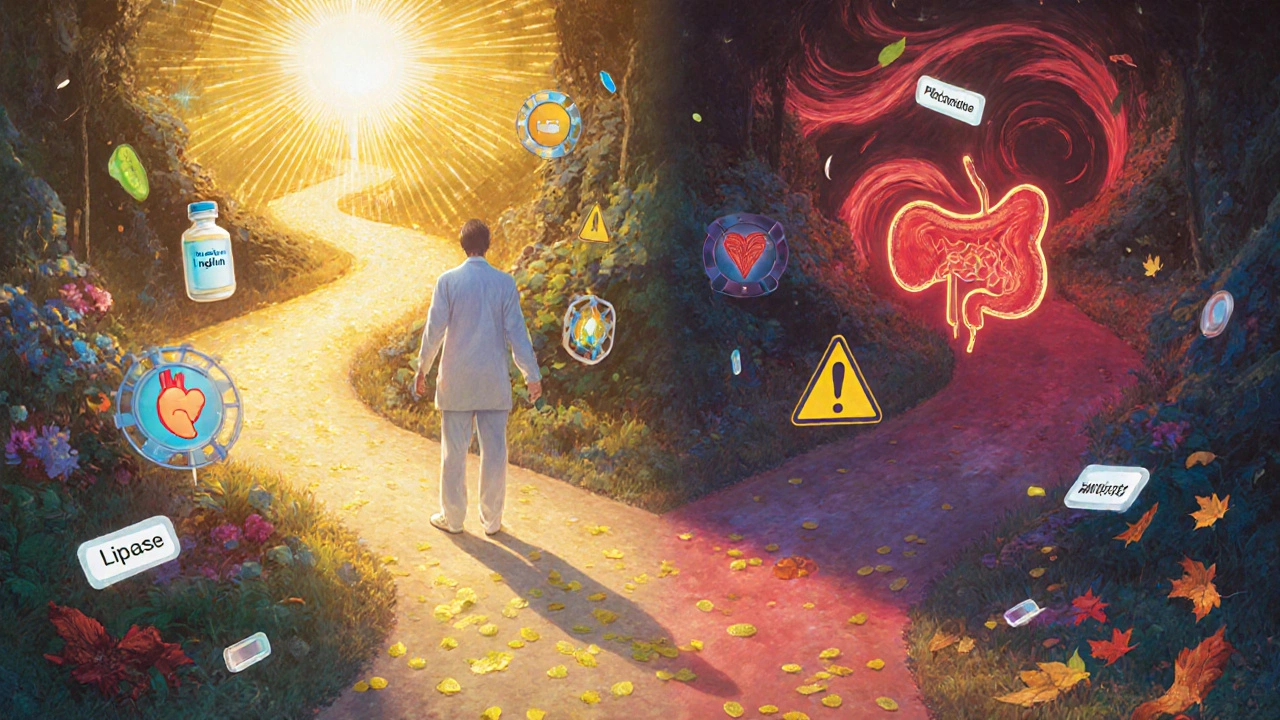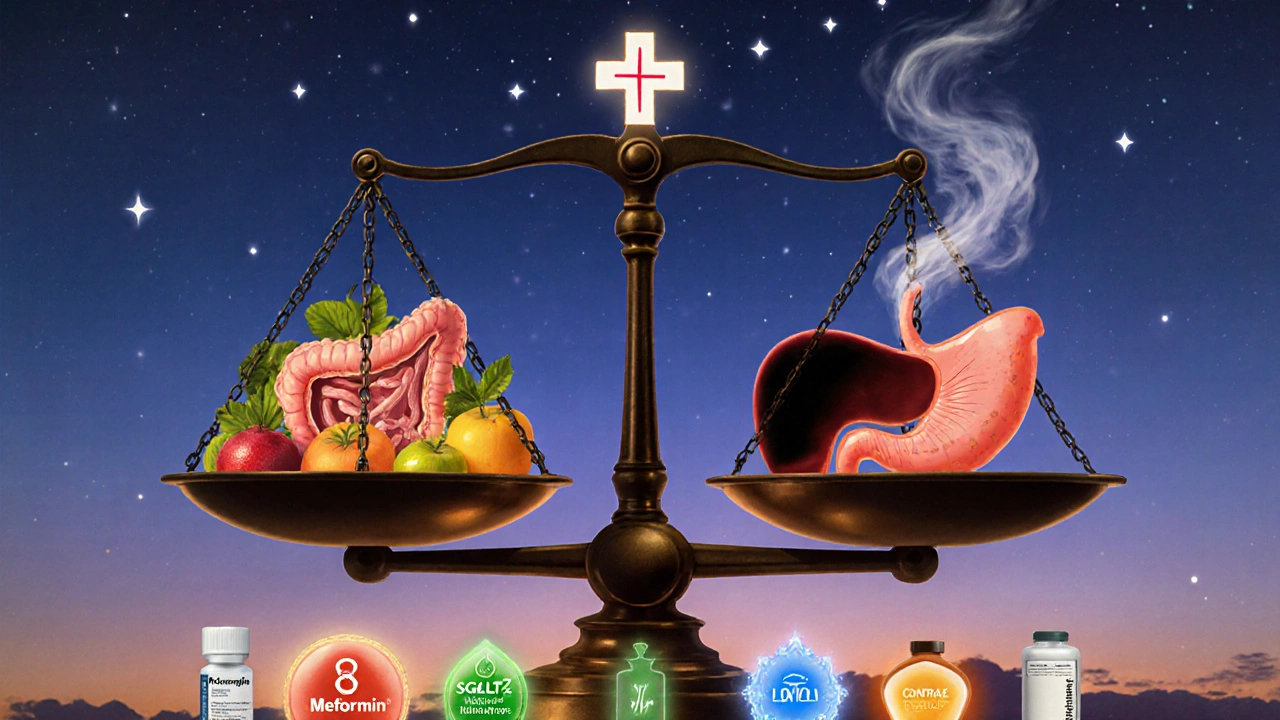GLP-1 Pancreatitis Risk Assessment Tool
Assess Your Pancreatitis Risk
This tool helps you understand your personal risk profile when taking GLP-1 agonists like Ozempic or Wegovy. Based on the latest medical research, it estimates your risk level and provides recommendations.
Your Risk Factors
Your Pancreatitis Risk Assessment
When you start taking a GLP-1 agonist like Ozempic or Wegovy for weight loss or type 2 diabetes, you’re not just getting a powerful tool for blood sugar control and appetite suppression. You’re also stepping into a medical landscape where the benefits are clear-but so are the lingering questions. One of the biggest concerns doctors and patients wrestle with is pancreatitis risk. Is it real? How big is it? And what should you do if you’re worried?
What Are GLP-1 Agonists, Really?
GLP-1 agonists are synthetic versions of a natural hormone your body makes after eating. This hormone, called glucagon-like peptide-1, tells your pancreas to release insulin when blood sugar rises. It also slows down digestion and makes you feel full longer. That’s why drugs like liraglutide (Victoza, Saxenda), semaglutide (Ozempic, Wegovy), and tirzepatide (Mounjaro, Zepbound) work so well for both diabetes and weight loss.
These medications aren’t new. The first one, exenatide, got FDA approval back in 2005. But since 2020, their popularity has exploded. In 2023, semaglutide alone brought in nearly $20 billion in global sales. Millions of people now take them-not just for diabetes, but for weight management. That’s why understanding the risks matters more than ever.
The Pancreatitis Debate: Contradictory Studies, Real Concerns
Here’s the problem: the science doesn’t agree.
In May 2025, a massive study of nearly a million diabetic patients found GLP-1 agonists increased the risk of chronic pancreatitis by 44.5% over five years. That’s a big red flag. Another study from January 2025 said the risk goes up with higher doses-more pills, more risk.
But then you read a February 2025 study in the Journal of Clinical Medicine that looked at almost a million people and found no meaningful increase in pancreatitis risk. In fact, the group taking GLP-1 agonists had a slightly lower lifetime risk than those who didn’t. And a major study presented at ENDO 2024 showed these drugs might even lower the chance of pancreatitis coming back in people who’d had it before.
So what’s going on?
One key difference: study design. Some studies compare GLP-1 users to people on no medication. Others compare them to people on other diabetes drugs. And some look at people with existing risk factors-like heavy drinking, smoking, or prior pancreatitis-while others don’t. The American College of Gastroenterology found that if you’ve had pancreatitis before, you’re not necessarily at higher risk when starting a GLP-1 agonist. But if you smoke, have advanced kidney disease, or very high triglycerides, your risk may go up.
What Does the FDA Say?
The FDA has required a pancreatitis warning on all GLP-1 agonist labels since 2007. The label for Wegovy (semaglutide), updated in October 2023, says: “Acute pancreatitis, including fatal and necrotizing pancreatitis, has been observed.”
But here’s the nuance: the FDA doesn’t say these drugs cause pancreatitis. It says it’s been reported. And in medicine, there’s a big difference between association and causation.
From 2005 to late 2024, the FDA received 1,842 reports of pancreatitis linked to GLP-1 agonists. That sounds scary-until you realize that millions of people have taken these drugs. The actual incidence? Studies suggest it’s between 0.1% and 0.4% over a lifetime. That’s rare. But rare doesn’t mean zero. And when it happens, it can be serious.

How to Monitor for Pancreatitis Risk
Most people will never have a problem. But if you’re at higher risk-or just want to be safe-here’s what to do.
- Know the symptoms. Sudden, severe pain in the upper abdomen that radiates to your back? That’s the #1 sign. Nausea, vomiting, and pain that gets worse after eating are also common. If you feel this, stop the drug and call your doctor immediately.
- Get baseline blood tests. Before starting, ask for serum lipase and amylase. These are enzymes your pancreas makes. High levels can signal inflammation. Not every doctor does this-but if you have a history of pancreatitis, high triglycerides, or heavy alcohol use, insist on it.
- Follow up if you’re high-risk. If you smoke, have chronic kidney disease, or triglycerides over 500 mg/dL, get blood tests every 3 months during the first year. After that, only test if symptoms appear.
- Don’t panic over minor belly discomfort. Nausea and bloating are common side effects of GLP-1 agonists. That’s not pancreatitis. True pancreatitis pain is intense, constant, and doesn’t go away with antacids or rest.
Alternatives to GLP-1 Agonists
If you’re worried about pancreatitis-or your doctor thinks you’re at higher risk-there are other options.
SGLT2 Inhibitors (Jardiance, Farxiga, Invokana)
These drugs work by making your kidneys flush out extra sugar. They’re great for heart and kidney protection. Studies show they don’t increase pancreatitis risk-and may even lower it compared to GLP-1 agonists. They’re often used alongside or instead of GLP-1 drugs.
Metformin
The oldest, cheapest, and safest first-line diabetes drug. It has a pancreatitis risk of about 0.15 per 1,000 patient-years. That’s lower than most other diabetes meds. It doesn’t cause weight loss like GLP-1 agonists, but it’s very effective for blood sugar and has decades of safety data.
DPP-4 Inhibitors (Januvia, Onglyza)
These are a mixed bag. Sitagliptin (Januvia) shows no increased risk. But saxagliptin (Onglyza) carries a black box warning for pancreatitis. If you’re switching from a GLP-1 agonist, stick with sitagliptin.
Bupropion-Naltrexone (Contrave)
This combo drug works on brain pathways to reduce cravings. A 2023 JAMA study found it had far lower pancreatitis risk than GLP-1 agonists. But it’s not for everyone-it’s not safe if you have seizures, eating disorders, or are on certain antidepressants.
Orlistat (Xenical)
It blocks fat absorption in your gut. Minimal pancreatic risk. But side effects-oily stools, frequent bowel movements-mean many people quit within a year.
Tirzepatide (Mounjaro, Zepbound)
This newer drug is a dual agonist-hits both GLP-1 and GIP receptors. It’s even more effective for weight loss than semaglutide. But because it’s structurally similar to GLP-1 agonists, the pancreatitis risk is still being studied. The FDA requires a long-term safety trial that won’t finish until 2027.

Who Should Avoid GLP-1 Agonists?
Not everyone needs to avoid them. But if you have any of these, talk to your doctor before starting:
- History of acute pancreatitis (but don’t assume it’s an automatic disqualifier-new data says it’s not)
- Chronic heavy alcohol use
- Smoking
- Triglycerides over 500 mg/dL
- Advanced chronic kidney disease (stage 4 or 5)
On the flip side, people with a BMI over 36 may actually have a lower risk of pancreatitis on these drugs. That’s counterintuitive-but it’s what the data shows.
The Bottom Line
GLP-1 agonists are among the most effective tools we have for managing type 2 diabetes and obesity. Their benefits-better blood sugar, weight loss, lower heart disease risk-are huge. But they’re not risk-free.
The pancreatitis risk is low. But it’s real. And it’s not the same for everyone.
If you’re considering starting one:
- Get your blood tested before you begin.
- Know the warning signs.
- Be honest with your doctor about your history-alcohol, smoking, past pancreatitis.
- Don’t assume the risk is the same for everyone. Your profile matters more than the drug class.
- Explore alternatives if you’re high-risk.
For most people, the benefits outweigh the risks. But for a small group, the risk is too high. That’s why personalized care-not blanket warnings-is the future of this treatment.
Do GLP-1 agonists cause pancreatitis?
GLP-1 agonists don’t definitively cause pancreatitis, but there’s a small increased risk in some people. Studies conflict: some show a higher risk, others show no increase or even lower risk. The FDA lists it as a possible side effect based on reported cases, but the actual incidence is low-around 0.1% to 0.4% over a lifetime. The risk appears higher in people who smoke, drink heavily, have high triglycerides, or advanced kidney disease.
What are the symptoms of pancreatitis from GLP-1 drugs?
Symptoms include sudden, severe pain in the upper abdomen that often radiates to the back, nausea, vomiting, and pain that worsens after eating. These are not mild digestive issues-they’re intense and persistent. If you experience these, stop the medication and seek medical attention immediately. Blood tests for lipase and amylase can confirm pancreatitis.
Should I get blood tests before starting a GLP-1 agonist?
Yes, if you have risk factors: prior pancreatitis, heavy alcohol use, smoking, triglycerides over 500 mg/dL, or advanced kidney disease. Even if you don’t have risk factors, asking for baseline lipase and amylase levels is a smart precaution. Many doctors skip this, but it gives you a reference point to compare against if symptoms appear later.
Are there safer alternatives to GLP-1 agonists for weight loss?
Yes. Metformin is very safe and helps with modest weight loss. SGLT2 inhibitors like Jardiance and Farxiga have neutral or protective effects on the pancreas. Bupropion-naltrexone (Contrave) has significantly lower pancreatitis risk than GLP-1 drugs, though it’s not suitable for everyone due to psychiatric contraindications. Orlistat has minimal pancreatic risk but causes gastrointestinal side effects that lead many to stop taking it.
Can I restart a GLP-1 agonist after having pancreatitis?
Recent research suggests you can. A 2024 study found that people with a history of acute pancreatitis did not have a higher risk of recurrence when starting a GLP-1 agonist. However, this should only be done under close medical supervision, after full recovery and with careful monitoring. Your doctor will weigh the benefits against your personal risk profile.
Is tirzepatide (Mounjaro) safer or riskier than semaglutide?
Tirzepatide is a newer dual agonist that targets both GLP-1 and GIP receptors. It’s more effective for weight loss than semaglutide, but because it’s structurally similar to GLP-1 drugs, the same theoretical pancreatitis risks apply. The FDA requires a long-term safety study that won’t be complete until 2027. Until then, treat it with the same caution as semaglutide and liraglutide.

Sam Reicks
November 18, 2025 AT 20:23glp-1 agonists are just another big pharma scam to make us dependent on drugs that dont even work long term
they know the pancreatitis risk is real but they bury the data in fine print
why do you think the FDA warning is buried under 30 pages of legalese
its all about profit not your health
my cousin took ozempic and ended up in the er with pancreatitis
they told him it was coincidence
coincidence my ass
theyre selling weight loss like its a miracle cure
but the real miracle is how much money they make off your fear of fat
wait till the lawsuits start rolling in
youll see
Chuck Coffer
November 20, 2025 AT 12:07Oh wow. A 44.5% increased risk? How shocking. I bet the next study will say eating bread increases the risk of gravity by 87%.
Somebody get this man a placebo and a life jacket.
Marjorie Antoniou
November 21, 2025 AT 03:53I appreciate how thorough this breakdown is. So many people are jumping on GLP-1 drugs without understanding the risks or alternatives.
As someone who’s watched a close friend navigate type 2 diabetes, I’ve seen how terrifying it is to be told ‘this drug might cause pancreatitis’-but then not given clear guidance on what to do next.
This post gives real, actionable steps: baseline labs, symptom awareness, alternatives. That’s what matters.
It’s not about fear. It’s about informed choice.
Thank you for writing this with such clarity.
Andrew Baggley
November 21, 2025 AT 04:51Look, I get the fear. But let’s put this in perspective.
GLP-1 drugs have helped millions lose weight, reverse prediabetes, and avoid heart attacks.
Pancreatitis risk? Yeah, it’s real-but it’s rarer than getting struck by lightning while winning the lottery.
And if you’re smoking, drinking like a sailor, and have triglycerides through the roof? Maybe don’t blame the drug.
My aunt started semaglutide at 68, lost 40 lbs, got off insulin, and now hikes every weekend.
She got her lipase checked before starting. Zero issues.
Don’t let fear stop you from living better.
Just be smart. Monitor. Talk to your doc.
That’s all.
Paige Lund
November 22, 2025 AT 17:55Wow. So much text. I’m just here for the memes.
Reema Al-Zaheri
November 23, 2025 AT 00:56The statistical analysis presented here is methodologically sound, yet it fails to account for the confounding variable of dietary compliance among users of GLP-1 agonists. Specifically, individuals who initiate these medications often simultaneously adopt low-carbohydrate, high-protein diets, which independently reduce pancreatic stress.
Moreover, the FDA’s adverse event reporting system is inherently biased toward underreporting of benign events and overreporting of dramatic outcomes.
It is therefore plausible that the observed risk differential is not attributable to the pharmacological action of GLP-1 agonists, but rather to the concomitant lifestyle modifications that accompany their use.
Additionally, the absence of longitudinal biomarker tracking in many cited studies limits causal inference.
One must also consider that the increased incidence of pancreatitis in certain subgroups may reflect pre-existing metabolic dysfunction rather than drug-induced pathology.
Thus, while the data warrant caution, they do not establish causation.
Further prospective, controlled trials with standardized dietary controls are required before policy recommendations can be made.
Michael Salmon
November 25, 2025 AT 00:33Oh great. Another article written by someone who thinks ‘44.5% increase’ means ‘half the population gets pancreatitis.’
Let me guess-you also think 0.4% risk is ‘high’ because you’ve never seen a spreadsheet?
Meanwhile, people are dying from obesity-related heart failure while you’re over here treating a drug like it’s poison.
GLP-1 drugs are the most effective tool we’ve had in 50 years.
Stop fearmongering.
And if you’re scared, don’t take it.
But don’t scare other people out of life-saving treatment because you don’t understand statistics.
Joe Durham
November 25, 2025 AT 20:57I’ve been on semaglutide for 18 months. Lost 52 lbs. No pancreatitis.
But I did get my labs done before starting-lipase, amylase, triglycerides.
My doc said I was low-risk: non-smoker, no alcohol abuse, normal triglycerides.
That’s the key.
It’s not ‘are GLP-1 drugs safe?’
It’s ‘am I a high-risk candidate?’
And if you are? There are alternatives.
This post nails it.
Not all-or-nothing.
Just smart, personalized care.
That’s what medicine should be.
Derron Vanderpoel
November 27, 2025 AT 04:13my heart just dropped when i read the pancreatitis risk part
i started ozempic last month and i’ve had this weird dull ache under my ribs for a week
is this normal?? or am i gonna die??
i’m not joking i’m 34 and i’ve never felt this scared about a med
should i stop??
my dr said ‘it’s probably just bloating’ but i don’t trust anyone anymore
help.
Timothy Reed
November 28, 2025 AT 19:10Thank you for this comprehensive, balanced overview.
As a primary care provider, I see patients every week who are terrified of GLP-1 drugs-or desperate to start them without any screening.
This post gives them exactly what they need: context, clarity, and actionable steps.
The emphasis on baseline labs, risk stratification, and alternatives is critical.
Too often, the conversation is reduced to ‘this drug is dangerous’ or ‘this drug is magic.’
Reality is messy.
And this reflects that.
Well done.
Christopher K
November 29, 2025 AT 19:55So let me get this straight-we’re supposed to be scared of a drug that helps Americans lose weight… while China’s getting fatter and we’re handing them our medical dominance?
Next thing you know, they’ll ban coffee because ‘it might cause anxiety’.
This is why America’s falling behind.
We’re too busy being scared of side effects to actually fix our health crisis.
Take the drug.
Get fit.
Stop whining.
And for god’s sake-stop smoking if you want to live.
harenee hanapi
December 1, 2025 AT 11:08Oh my god, I’ve been waiting for someone to finally talk about this.
My best friend’s sister’s cousin took Ozempic and got pancreatitis and now she’s on a feeding tube and her husband left her and her kids are in therapy and she says she regrets it every single day and I’ve been telling everyone for months that these drugs are dangerous and no one listens and now I feel so validated but also so sad for her and I just wish people would stop being so reckless with their bodies and think about the consequences and I’m not saying don’t take them I’m saying be careful and get tested and maybe just eat less cake and exercise more like in the old days when we didn’t have all these fancy pills and I’m just so emotional about it I could cry right now.